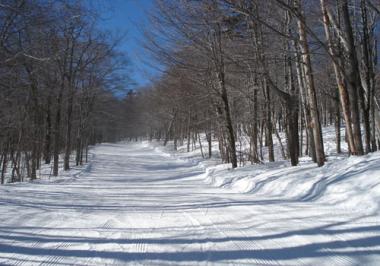Picking your favorite trail to ski or ride is as subjective as choosing a favorite song. Depending on your mood at the time, it could be a rock, hip-hop or folk song or an old standard. Ski areas within an easy drive from the Valley have trails with as much of a variety. Here are a few of my picks for some favorites that I've come to frequent over the years.
Butternut: "Whip" to "Main Street." The most-difficult "Whip" twists, turns and falls as it empties out onto "Main Street." It isn't extremely steep, but it is narrow, with woods on both sides. Things get easier on "Main Street." Cruise the lower half of the mountain on this trail to the base.
Catamount: "Alley Cat." This trail has a few drops that keep your speed in check. It's a black diamond that is wide enough for carving some big, fast turns.
Berkshire East: "Minnie Dole." It's named after C. Minot Dole, the guy who founded the National Ski Patrol 70 years ago this March. It falls steeply off to the left and meets up with "Grizzly." The lower section is a great fall line cruiser that holds fresh snow really well.
Jiminy Peak: "Whitetail." It's one of the steepest trails at Jiminy. It runs alongside a quad chair, so it is a great show-off run. The chair beside it starts partway up the mountain, so it is usually less crowded.
Mount Snow: "Uncle's." A narrow, twisting trail you access from "Deer Run." It's not steep, but you have to be on your toes. It's a laugh to have someone with you who has never been on it and hear their reaction to the surprises it throws them.
Stratton: "Get My Drift" to "Upper Drifter" to "Lower Drifter." All three are easier than the other trails in the Snow Bowl section of the mountain, but great relaxing cruisers. You may take the Snow Bowl chair back up or continue down to the base.
Okemo: "World Cup." This trail is steeper up top and has occasional drops where you can catch your breath. Otherwise, it challenges you to keep going and take the whole trail in one fell swoop. Near the bottom, you may stay toward the left for an easier descent or stick to the right for a steeper pitch.
All of the above trails have designations to alert skiers or snowboarders to the expertise required to ski them. A green circle denotes a trail that is easiest; a blue square means that trail is more difficult; a black diamond designates a most-difficult trail. Some ski areas have trails with a double black diamond. That means those trails are super difficult. But trail markers are only an indication of the degree of difficulty at that particular area.
They shouldn't be considered beginner, intermediate, expert and super expert trails. That's because a black diamond trail at a smaller mountain would probably be a blue square somewhere else. If there were a general designation for trails (don't worry—there never will be) some ski areas would be mostly easy and others mostly difficult.
Both the bigger and smaller areas want to have the same percentages of degrees of difficulty assigned to their trails for marketing purposes. The closer they can get to 30-40-30 the better. For example, the smaller Catamount in the Berkshires lists its trails as 40 percent green circles, 27 percent blue squares and 33 percent black or double black diamonds, while the bigger, more difficult Magic Mountain in Vermont notes it has 33 percent green, 30 percent blue and 37 percent black or double black trails. However, looking up at them from their respective parking lots, they are quite different.



